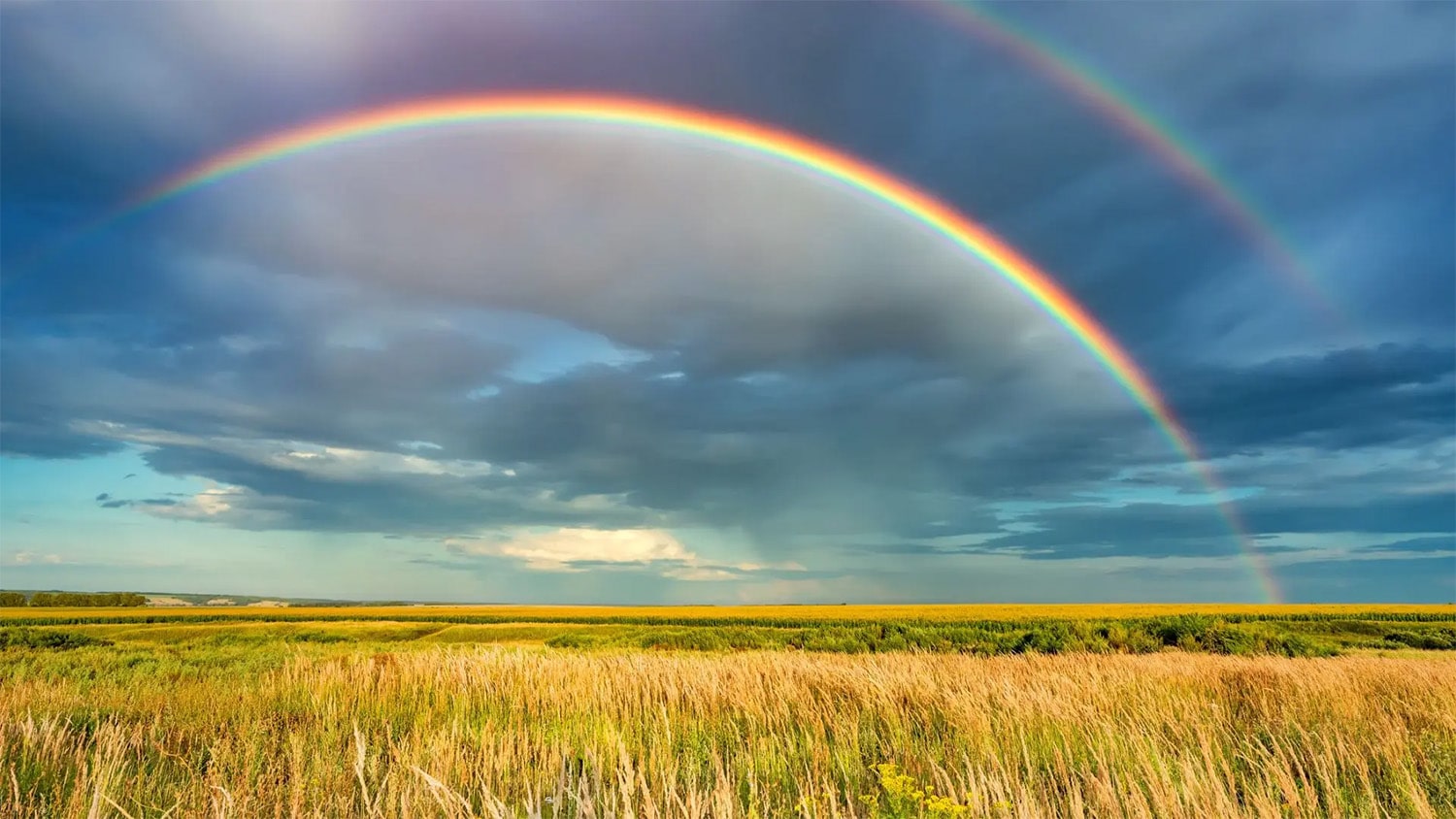
35 interesting facts about Rainbows
- 👁️ 389
Rainbows, those magnificent arcs of color that appear in the sky, have fascinated humanity since time immemorial. They occur when sunlight is refracted, or bent, and then reflected inside water droplets in the Earth’s atmosphere, creating a spectrum of light in the sky. Each rainbow is a personal, optical phenomenon that is unique to each observer’s standpoint, blending science with a touch of magic. Beyond their beauty, rainbows hold a place in various cultures’ myths and legends, symbolizing peace, hope, and promise. Here are 35 interesting and informative facts about rainbows that highlight their natural wonder and the science behind their formation.
- A rainbow is a spectrum of light that appears when sunlight passes through water droplets in the atmosphere.
- The traditional description of the rainbow’s colors is red, orange, yellow, green, blue, indigo, and violet (ROYGBIV).
- Rainbows are actually full circles, but the ground obstructs the bottom half from view.
- The angle at which light hits the water droplet to create a rainbow is approximately 42 degrees to the observer’s line of sight.
- Double rainbows occur when light is reflected twice inside water droplets, with the second rainbow appearing above the first and the color order reversed.
- The Alexander’s band is the dark area between the primary and secondary rainbows in a double rainbow.
- Rainbows can appear at night and are known as moonbows or lunar rainbows, formed by moonlight rather than sunlight.
- No two people can see the exact same rainbow because each observer is viewing from a slightly different angle.
- Rainbows cannot be physically approached or touched, as they are an optical effect that moves with the observer.
- The world record for the longest-lasting rainbow observed is nearly 9 hours, recorded in Taiwan.
- Rainbows are often used in mythology and religion to symbolize hope and promise, such as the biblical story of Noah’s Ark.
- Supernumerary rainbows are faint arcs that appear inside the primary rainbow, caused by diffraction of light.
- The size of the water droplets has an effect on the appearance of the rainbow, with smaller droplets creating thinner and fainter rainbows.
- In a primary rainbow, the red band appears on the outer edge and the violet on the inner edge.
- Rainbows can also form around fog, mist, and even waterfalls.
- The scientific study of rainbows and similar phenomena is called iridology.
- Rainbows were first explained scientifically by René Descartes in 1637.
- The term “rainbow” originates from the Latin word arcus pluvius, meaning “rainy arch.”
- Circular rainbows can sometimes be seen from an airplane, with the shadow of the plane in the center.
- Rainbows appear opposite the sun from the observer’s perspective.
- A reflection rainbow is formed by sunlight that is first reflected off a body of water before it forms a rainbow.
- In Greek mythology, rainbows were considered to be a path made by the messenger Iris between Earth and Heaven.
- Rainbows have been depicted in art and literature for centuries as symbols of peace and hope.
- The process of light refraction, reflection, and dispersion in water droplets that creates rainbows is also responsible for the splitting of light in prisms.
- Red rainbows, or monochrome rainbows, can occur at sunrise or sunset, where the shorter wavelengths of light are scattered, leaving only the red spectrum visible.
- The colors of a rainbow do not have a specific start or end point, and the spectrum is continuous.
- Triple and even quadruple rainbows can occur, but they are extremely rare and difficult to observe.
- Isaac Newton added indigo and orange to the color spectrum to have seven colors, matching the number of musical notes in a scale, days in the week, and known planets at the time.
- The rainbows caused by very small droplets, such as those in mist or fog, are often white and known as fog bows.
- Sleet and hail can also produce rainbows if the conditions are right, although they are less common.
- Rainbows are a universal symbol of peace and are used in many flags and emblems around the world.
- The highest number of rainbows seen in one location tends to occur in tropical regions where rain showers and sunlight frequently coincide.
- A “fire rainbow” is not a rainbow but a circumhorizontal arc, an optical phenomenon created by ice crystals in cirrus clouds.
- Theories and experiments on rainbows can be traced back to ancient civilizations, including the Greeks and Arabs.
- The primary rainbow forms at an angle of about 40 to 42 degrees, while the secondary rainbow forms at an angle of about 50 to 53 degrees.
Rainbows serve as a mesmerizing reminder of the natural beauty that surrounds us and the intricate processes at play in our atmosphere. These colorful arcs bridge the gap between the scientific and the mystical, offering a spectacle that has captivated human imagination for millennia. From their role in mythology and culture to the complex physics behind their formation, rainbows are a fascinating subject of study and admiration. As symbols of hope and renewal, they remind us of the wonder and majesty of the natural world. Each appearance of a rainbow, whether it be a common sight after a storm or a rare nocturnal phenomenon, invites us to pause and appreciate the ephemeral beauty that can emerge from the interplay of light and water.
Rainbows, those magnificent arcs of color that appear in the sky, have fascinated humanity since time immemorial. They occur when sunlight is refracted, or bent, and then reflected inside water droplets in the Earth’s atmosphere, creating a spectrum of light in the sky. Each rainbow is a personal, optical phenomenon…